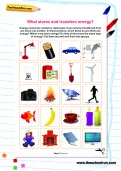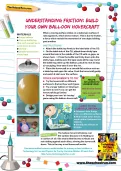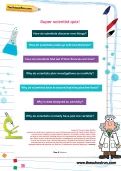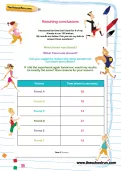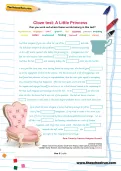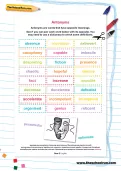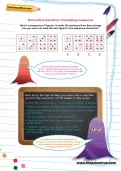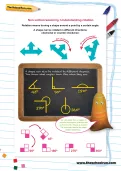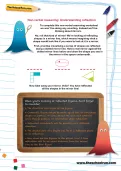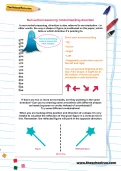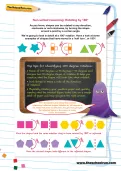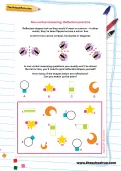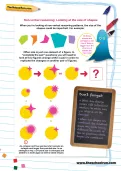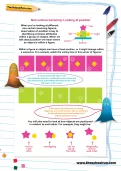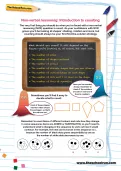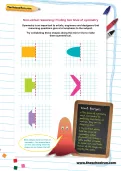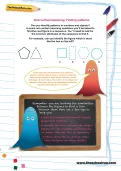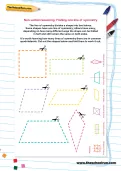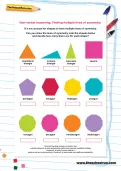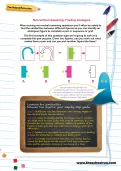Can you work out where these words belong in this text?
or
Register to add to your saved resources
Already a subscriber? to view this content.
Antonyms are words that have opposite meanings. See if you can pair each word below with its opposite. You may need to use a dictionary to check some definitions
or
Register to add to your saved resources
Already a subscriber? to view this content.
Here’s a sequence of figures, in order. By looking at how they change can you work out what the next figure in the sequence should be? Now, are you ready to do some complete-the-series questions?
Then let’s begin!
or
Register to add to your saved resources
Already a subscriber? to view this content.
Something is symmetrical when it is the same on both sides. A shape has symmetry if a central dividing line (a mirror line) can be drawn on it, to show that both sides of the shape are exactly the same. Looking at the shapes below, which ones don’t have a line of symmetry?
or
Register to add to your saved resources
Rotation means turning a shape around a point by a certain angle. A shape can be rotated in different directions, clockwise or counter-clockwise. Rotate the figure on the left by 90º. What will the rotated
shape look like?
or
Register to add to your saved resources
Already a subscriber? to view this content.
Reflecting shapes in a mirror line means imagining what a shape would look like if you were to look at it in a mirror. Which figure on the right is the reflection of the shape given on the left along the dotted mirror line?
or
Register to add to your saved resources
Already a subscriber? to view this content.
In non-verbal reasoning, direction is also referred to as orientation – in other words, the way a shape or figure is positioned on the paper, which tells us which direction it’s pointing to. Have a go at these practical non-verbal puzzles and remember to think about the direction each shape is pointing in. Find the odd one in the group of figures.
or
Register to add to your saved resources
Already a subscriber? to view this content.
Shapes can be rotated in any direction, clockwise or anti-clockwise, by turning the shape around a point by a certain angle. We’re going to look in detail at a 180° rotation. How would the figure on the left look when rotated by 180º clockwise?
or
Register to add to your saved resources
Already a subscriber? to view this content.
Rotating a shape means turning it around a point by a certain angle, clockwise or counter-clockwise. Now we’re going to focus on a tricky rotation, 45º. It’s hard to identify, but it shows a movement of 1/8 of a complete turn. How would the figure on the left look when rotated by 45º clockwise?
or
Register to add to your saved resources
Already a subscriber? to view this content.
Reflected shapes look as they would if seen in a mirror – in other words, they’ve been flipped across a mirror line. In non-verbal reasoning questions you usually won’t be shown the mirror line, you’ll need to spot reflected shapes yourself! Can you find the reflection of the shape on the left?
or
Register to add to your saved resources
Already a subscriber? to view this content.
When you’re looking at non-verbal reasoning patterns, the size of the shapes could be important. Can you solve these analogy questions?
or
Register to add to your saved resources
Already a subscriber? to view this content.
When you’re looking at different non-verbal reasoning figures, observation of position is key to identifying common attributes within a group of shapes. When we talk about position we mean where an object is within a figure. Are you ready to check your understanding of position in some non-verbal reasoning figures? Which figure belongs to the group?
or
Register to add to your saved resources
Already a subscriber? to view this content.
11+ non-verbal reasoning worksheet created by an 11+ expert. Includes non-verbal reasoning examples and answers.
or
Register to add to your saved resources
Being able to identify rotated shapes takes lots of practice! Which of these shapes can be formed by shrinking the shape on the left and rotating it?
or
Register to add to your saved resources
Already a subscriber? to view this content.
Symmetry is so important to artists, engineers and designers that reasoning questions give a lot emphasis to the subject. Can you work out which of these figures has TWO lines of symmetry?
or
Register to add to your saved resources
Already a subscriber? to view this content.
Can you identify patterns in numbers and objects? In some non-verbal reasoning questions you’ll be asked to find the next figure in a sequence. You’ll need to look for the common attributes of the sequence to find it. Find one figure from the group on the right that belongs to the group on the left.
or
Register to add to your saved resources
Already a subscriber? to view this content.
Sometimes a non-verbal reasoning question will ask you to focus on shapes with a specific number of lines of symmetry. Which of these figures has only ONE line of symmetry?
or
Register to add to your saved resources
Already a subscriber? to view this content.
It’s not unusual for shapes to have multiple lines of symmetry. Can you draw the lines of symmetry onto the shapes below and decide how many there are for each shape? Then work out which of the figures has MORE THAN TWO lines of symmetry.
or
Register to add to your saved resources
Already a subscriber? to view this content.
When solving non-verbal reasoning questions you’ll often be asked to find the similarities between different figures so you can identify an analogous figure to complete a pair or sequence or grid. Can you solve this ‘complete the pair’ puzzle by choosing the correct option?
or
Register to add to your saved resources
Already a subscriber? to view this content.
Are you ready to decode some codes? Work out the code for the fifth shape.
or
Register to add to your saved resources
Already a subscriber? to view this content.
